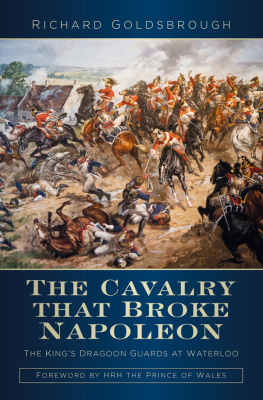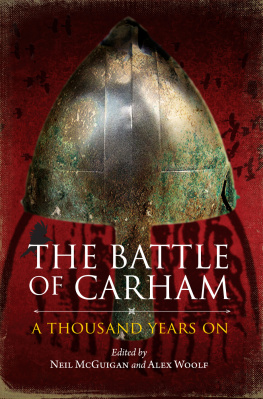Robert Burnham and Ron McGuigan - Wellington’s Foot Guards at Waterloo
Here you can read online Robert Burnham and Ron McGuigan - Wellington’s Foot Guards at Waterloo full text of the book (entire story) in english for free. Download pdf and epub, get meaning, cover and reviews about this ebook. year: 2018, publisher: Pen and Sword, genre: Non-fiction. Description of the work, (preface) as well as reviews are available. Best literature library LitArk.com created for fans of good reading and offers a wide selection of genres:
Romance novel
Science fiction
Adventure
Detective
Science
History
Home and family
Prose
Art
Politics
Computer
Non-fiction
Religion
Business
Children
Humor
Choose a favorite category and find really read worthwhile books. Enjoy immersion in the world of imagination, feel the emotions of the characters or learn something new for yourself, make an fascinating discovery.
- Book:Wellington’s Foot Guards at Waterloo
- Author:
- Publisher:Pen and Sword
- Genre:
- Year:2018
- Rating:5 / 5
- Favourites:Add to favourites
- Your mark:
- 100
- 1
- 2
- 3
- 4
- 5
Wellington’s Foot Guards at Waterloo: summary, description and annotation
We offer to read an annotation, description, summary or preface (depends on what the author of the book "Wellington’s Foot Guards at Waterloo" wrote himself). If you haven't found the necessary information about the book — write in the comments, we will try to find it.
Wellington’s Foot Guards at Waterloo — read online for free the complete book (whole text) full work
Below is the text of the book, divided by pages. System saving the place of the last page read, allows you to conveniently read the book "Wellington’s Foot Guards at Waterloo" online for free, without having to search again every time where you left off. Put a bookmark, and you can go to the page where you finished reading at any time.
Font size:
Interval:
Bookmark:

WELLINGTONS FOOT GUARDS AT WATERLOO
WELLINGTONS FOOT GUARDS AT WATERLOO
THE DAY AGAINST NAPOLEON
ROBERT BURNHAM AND RON M c GUIGAN


WELLINGTONS FOOT GUARDS AT WATERLOO
The Men Who Saved The Day Against Napoleon
First published in Great Britain in 2018 by Frontline Books, an imprint of Pen & Sword Books Ltd, Yorkshire - Philadelphia
Copyright Robert Burnham and Ron McGuigan
ISBN: 978-1-52670-986-8
eISBN: 978-1-52670-988-2
Mobi ISBN: 978-1-52670-987-5
The right of Robert Burnham and Ron McGuigan to be identified as Authors of this work has been asserted by them in accordance with the Copyright, Designs and Patents Act 1988. A CIP catalogue record for this book is available from the British Library All rights reserved.
No part of this book may be reproduced or transmitted in any form or by any means, electronic or mechanical including photocopying, recording or by any information storage and retrieval system, without permission from the Publisher in writing.
Pen & Sword Books Ltd incorporates the imprints of Pen & Sword Archaeology, Air World Books, Atlas, Aviation, Battleground, Discovery, Family History, History, Maritime, Military, Naval, Politics, Social History, Transport, True Crime, Claymore Press, Frontline Books, Praetorian Press, Seaforth Publishing and White Owl
For a complete list of Pen & Sword titles please contact:
PEN & SWORD BOOKS LTD
47 Church Street, Barnsley, South Yorkshire, S70 2AS, UK.
E-mail:
Website: www.pen-and-sword.co.uk
Or
PEN AND SWORD BOOKS,
1950 Lawrence Road, Havertown, PA 19083, USA
E-mail:
Website: www.penandswordbooks.com
T his book would not have been possible without the groundwork laid by Gareth Glover. Over the past two decades he has found, edited, and published hundreds of letters, memoirs, and diaries by British soldiers who fought in the Napoleonic Wars. About 75 per cent of the sources that we used can be directly linked to his efforts. He has also been generous with his time and has provided transcripts of yet to be published sources as well as images from his personal collection. Another is Barbara Chambers who spent decades researching the 1st Foot Guards and compiled records on thousands of them who fought at Waterloo. Much of the personal data on the enlisted soldiers was unearthed by her. Rod MacArthur is another whom I cannot say too much about. He is a storehouse of arcane knowledge on the internal workings of the regiments of the British Army. Rod was able to come up with answers to questions on British drill and regulations that had appeared to be lost over the centuries. We spent many hours with Dr. Mick Crumplin, the foremost authority on British military medical practices of the Napoleonic Wars. His insights on casualties in general, but also specifically at Hougoumont, allowed us to come up with some key analysis on what happened to the wounded there. Then there is also Alasdair White, who lives a few kilometres from Hougoumont, who answered many questions on the layout of the complex. And, of course, David Beckford, our cartographer, who drew the map of Hougoumont.
Then there are those of the Napoleon Series Community who are always willing to answer almost any question we pose: Kevin Kiley, our artillery expert; Paul Dawson whose vast files on the French Imperial Guard was instrumental in our being able to provide full names of French officers; Andrew Bamford who provided help in understanding British strength returns; Wu Tian who got us searching in the right direction for Sous-Lieutenant Jeandot; and Steven Smith who filled in many details on the Siege of Pronne. We thought we had him stumped on this one, but as usual he was able to dig up some of the most obscure sources.
We would be remiss to not thank our long-time friends and supporters who help us with all of our books: Antony Broughton, who once again has opened his personal library of antique books and military prints for us to use; Rory Muir who answered numerous questions on the military politics of the era; and Howie Muir, who gave us his research on how the Foot Guards formed up and manoeuvred at Waterloo.
Several institutions were also generous in their help: the Cavalry and Guards Club for their permission to use the painting on our cover, the Anne S.K. Brown Military Collection at Brown University for several images, and the Huntington Library in San Marino, California. We also need to recognize the importance of the online resources that were so helpful : London Gazette online, Google Books, and Hathi Trust Digital Library. It was through them were we able to access so many books that could only be found in a few libraries in the world.
A sincere thank you to John Grehan and Martin Mace, our publishers, who quickly gave approval for the book.
Last but most importantly we need to acknowledge our wives, Denah Burnham and Deb McGuigan. Once again, they have patiently waited while we did our research, wondered when we would get off the computer, even listened to the anecdotes we had found, and not asked too often when we would do some chores. They have definitely made it easy for us.
Robert Burnham and Ron McGuigan,
April 2018.
T he date of 18 June 1815, is one of the proudest in the history of the British Foot Guards. Their participation in the defence of the Chateau of Hougoumont and the defeat of the French Imperial Guard is long remembered and celebrated. Yet, the Foot Guards contributed much more to the campaign of 1815. This book is an examination of the Foot Guards and their contributions.
The Foot Guards are the Household Troops of the sovereigns of Great Britain and Ireland. They trace their history as Guards from the Restoration of the British Monarchy in 1660 after the English Civil War. The 1st Foot Guards are the former Royalist Guards of King Charles II, while the 2nd Foot Guards are a former Parliamentary Regiment. They were stationed in Coldstream, Scotland, and take their name from there. Although named for a town in Scotland, they are an English Regiment. They are commonly called the Coldstream Foot Guards and are not usually referred to by their number. They existed before the 1st Foot Guards and resent being numbered second. Their motto Nulli Secundus [or Second to None] reflects this. The 3rd Foot Guards were newly raised in Scotland in 1660.
At the time of Waterloo, the regiments were known as: 1st Regiment of Foot Guards, Coldstream Regiment of Foot Guards and 3rd Regiment of Foot Guards. The three Foot Guard regiments never exceeded the combined total of seven permanent battalions. The three regiments exist today as the Grenadier Guards, Coldstream Guards and Scots Guards.
As well as their primary function of guarding the sovereign, the Foot Guards were available for active service and made many of the campaigns of the seventeenth, eighteenth and nineteenth centuries. However, before and during the Napoleonic Wars, they did not garrison overseas colonies.
Officers would be promoted in the regiment by regimental rank but would be promoted in the Army by Army rank. Similarly, officers would exchange regiments based upon their Army rank. Thus, a captain and lieutenant colonel commanding a company in the Foot Guards would become a lieutenant colonel commanding a battalion in a line regiment upon exchange.
Font size:
Interval:
Bookmark:
Similar books «Wellington’s Foot Guards at Waterloo»
Look at similar books to Wellington’s Foot Guards at Waterloo. We have selected literature similar in name and meaning in the hope of providing readers with more options to find new, interesting, not yet read works.
Discussion, reviews of the book Wellington’s Foot Guards at Waterloo and just readers' own opinions. Leave your comments, write what you think about the work, its meaning or the main characters. Specify what exactly you liked and what you didn't like, and why you think so.











